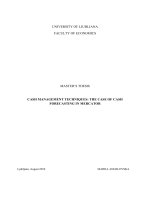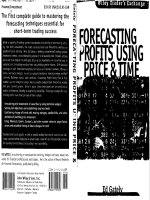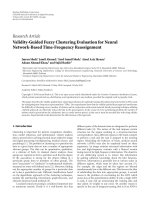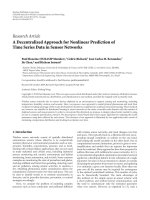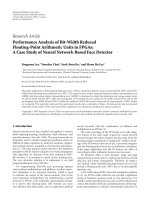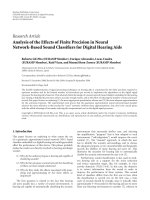Electricity price time series forecasting in deregulated markets using recurrent neural network based approaches
Bạn đang xem bản rút gọn của tài liệu. Xem và tải ngay bản đầy đủ của tài liệu tại đây (3.43 MB, 205 trang )
E
LECTRICITY PRICE TIME SERIES FORECASTING IN DEREGULATED MARKETS
USING RECURRENT NEURAL NETWORK BASED APPROACHES
VISHAL SHARMA
A THESIS SUBMITTED
FOR THE DEGREE OF DOCTOR OF PHILOSOPHY
DEPARTMENT OF ELECTRICAL & COMPUTER ENGINEERING
NATIONAL UNIVERSITY OF SINGAPORE
2011
1
Acknowledgements
It is a pleasure to thank the many people who made this thesis possible.
It is difficult to overstate my gratitude to my Ph.D. supervisor, Assoc. Prof. Dipti Srinivasan.
With her enthusiasm, her inspiration, and her great efforts helped to make neural networks
and nonlinear theory fun for me. Throughout my thesis-writing period, she provided
encouragement, sound advice, good teaching, good company, and lots of good ideas. I
would have been lost without her support.
My warmest thanks and regards to the Power Systems Laboratory Officer Mr. Seow Heng
Cheng for his helpful nature and dedication in making the laboratory such a nice place to
work. I would also like to thanks Electrical Machines Laboratory Officer Mr. Woo Ying Chi.
Without their support, it would have been impossible to carry out the research in the
laboratory.
I am indebted to my many student colleagues, roommates and friends for providing a
stimulating and fun environment in which to learn and grow. I am especially grateful to
Vicky Lu SiYan, Atul Karande, Anupam Trivedi, Balaji Parasumanna Gokulan, Dr. Raju Kumar
Gupta, Dr. Naran Pindoriya, Dr. Deepak Sharma, Dr. Yogesh Kumar Sharma, Sujit Kumar
Barik and Ravi Tiwari. I would like to thank them for helping me get through the difficult
times, and for all the emotional support, comraderie and caring they provided.
I wish to thank my brother, my sister in law and my beloved niece for providing a loving
environment for me.
2
Lastly, and most importantly, I wish to thank my parents. I would have never reached so far
in life without their constant love, support and encouragement. They bore me, raised me,
supported me, taught me, and loved me. To them I dedicate this thesis.
3
CONTENTS
ACKNOWLEDGEMENTS ……………………………………………………………………………………………………1
CONTENTS ……………………………………………………………………………………………………………………….3
Summary … ……………………………………………………………………………………………………… 7
CHAPTER1
INTRODUCTION ……………………………………………………………………………………………………………… 18
CHAPTER 2
NEURAL NETWORKS ………………………………………………………………………………………………………. 28
2.1 Learning in Neural Network ……………………………………………………………………………… 30
2.2 Stability of Neural Learning Algorithms …………………………………………………………… 33
2.3 Issues in NN Learning and Applications …………………………………………………………… 34
2.4 Implementation Example ………………………………………………………………………………… 40
2.4.1 Function Approximation ………………………………………………………………………… 40
2.4.2 Pattern Classification …………………………………………………………………………… 42
2.5 Summary ………………………………………………………………………………………………………… 46
CHAPTER 3
DEREGULATED ELECTRICITY MARKETS AND VOLATILITY ………………………………………………. 47
3.1 Alternate Deregulation Models ………………………………………………………………………… 49
3.2 Factors Affecting Volatility ……………………………………………………………………………… 50
3.3 Models of Spot Prices ………………………………………………………………………………………. 51
3.4 Market Design, Market Power and Pricing ……………………………………………………… 54
3.5 Summary ………………………………………………………………………………………………………… 59
4
CHAPTER 4
DYNAMIC CHARACTERISTICS OF ELECTRICITY PRICE TIME SERIES …………………………………. 60
4.1 Embedding Dimension …………………………………………………………………….………………… 61
4.2 Fixed Point Characteristics …………………………………………………………….………………… 64
4.2.1 Locating Fixed Point …………………………………………………………….….……………… 65
4.2.2 Dynamics in Neighborhood of Fixed Point ………………………………………….……. 66
4.3 Lyapunov Exponents …………………………………………………………………………………………….67
4.4 Finite Time Lyapunov Exponent Analysis and Local Instability ………………………… 68
4.5 Scale Dependent Lyapunov Exponent ……………………………………………………… ……… 71
4.6 Summary …………………………………………………………………………………………………………… 74
CHAPTER 5
ELECTRICITY PRICE TIME SERIES PREDICTION USING RNN TRAINED USING
INVARIANT DYNAMICS
……………………………………………………………………………….…….…………… 76
5.1 Introduction …………………………………………………………………………………………………… 76
5.2 Weight Initialization ………………………………………………………….……………………………… 79
5.2.1 Identifying Fixed Point Location and Neighbourhood Dynamics ……………… 79
5.2.2 Fixed Point Based Initialization …………………… ………………………………………… 82
5.3 Fixed Point Constraint During Learning ……………………………………………… ………… 86
5.3.1 Extension to Nonlinear Constraint ………………………………………………………… 89
5.4 Local Jacobian Learning ……………………………………………………………………………………. 91
5.5 Summary ………………………………………………………………………………………………………… 92
CHAPTER 6
ELECTRICITY PRICE TIME SERIES PREDICTION USING HYBRID RNN-FHN MODEL ……………. 94
6.1 Multiple Scale Dynamics in Electricity Price Time Series …………………………………… 95
6.2 Fitz-Hugh Nagumo Model ………………………………………………………………………………… 100
5
6.3 Proposed Model ………………………………………………………………………………………………… 101
6.4 Training of RNN in Hybrid Model ……………………………………………………………………… 103
6.5 Prediction of Hourly Prices …………………………………………………………………….…………….105
6.6 Training and Testing Data ………………………………………………………………………………… 106
6.7 Experimental Results …………………………………………………………………………………………. 108
6.8 Interval Forecasting ……………………………………………………………………………………………. 112
6.9 Summary …………………………………………………………………………………………………………… 118
CHAPTER 7
Multiscale Modelling of Electricity Price Time Series using Multi-Scale Neural Network 119
7.1 Slow-Fast Systems ………………………………………………………………………………… ……………120
7.2 Multi-Scale Recurrent Neural Network (MSRNN) ………………………………….……………. 123
7.3 MSRNN for Electricity Price Modeling …………………………………………………….………… 124
7.4 MSRNN Learning …………………………………………………………………………………… …………. 127
7.5 Summary ………………………………………………………………………………………………….………… 130
CHAPTER 8
RESULTS AND DISCUSSION ………………………………………………………………………………………………. 131
8.1 Data and Preliminary Statistical Analysis …………………………………………………………… 131
8.1.1 Data ………………………………………………………………………………………………………… 131
8.1.2 Summary Statistics ……………………………………………………………………………………. 133
8.2 Forecasting Indices Used ……………………………………………………………………………………. 136
8.3 PGRNN Implementation Results …………………………………………………………………………. 137
8.3.1 Results for PJM market ……………………………………………………………………………… 140
8.3.2 Results for Ontario market ………………………………………………………………………… 143
8.3.3 Results for Victoria market ………………………………………………………………………… 145
6
8.3.4 Results for NSW market ………………………………………………………… ……………… 147
8.4 RNNFHN Implementation Results ………………………………………………………….…….…… 149
8.4.1 Results for Ontario market ……………………………………………………………… ….…… 150
8.4.2 Results for PJM market ……………………………………………………………………………… 152
8.4.3 Results for Victoria market ………………………………………………………………………… 155
8.4.4 Results for NSW market ……………………………………………………………….……………. 157
8.5 MSRNN Implementation Results ………………………………………………………………….……… 159
8.5.1 Results for Ontario market ……………………………………………………………………… 161
8.5.2 Results for PJM market …………………………………………………………………….……… 163
8.5.3 Results for Victoria market …………………………………………………………………….… 165
8.5.4 Results for NSW market ………………………………………………………………….…………. 167
8.6 Comparison of Performance of Three Proposed Models …………………………………… 170
8.7 Error Histogram Analysis …………………………………………………………………………………… 171
8.8 Discussion ………………………………………………………………………………………………….……… 175
8.9 Limitations of Developed Models …………………………………………………………………….…. 178
8.9.1 Limitation of PGRNN …………………………………………………………………………………. 178
8.9.2 Limitation of RNNFHN ……………………………………………………………………………… 178
8.9.3 Limitation of MSRNN ……………………………………………………………………….………… 178
CHAPTER 9
CONCLUSION AND FUTURE WORK ………………………………………………………………………………… 180
9.1 List of Achievements ……………………………………………………………………………… …….…… 183
9.2 Future Work ……………………………………………………………………………………………………… 184
REFERENCES ……………………………………………………………………………………………………………… …… 186
7
Summary
Electricity Price Time Series Forecasting in Deregulated Markets Using Recurrent Neural
Network Based Approaches
In the past decade, electricity price time series system originating from recently deregulated
electricity markets has been the focus of study for many researchers and power system
engineers. These are complex dynamical systems which have tipping points at which sudden
shifts to a spiking dynamical regime occurs. Although there are several techniques available
for short term forecasting of electricity prices, very little has been done for accurate
prediction of spikes along with otherwise volatile region of time series. High volatility and
intermittent spikes are hallmarks of chaos taking place in electricity price time series.
Modeling these systems require a dynamic approach with accurate approximation
capabilities, such as recurrent neural networks. Recently recurrent neural networks have
gained immense interest due to their unconventional ability to solve complex problems.
However training them in complex dynamic environments such as electricity price time
series is a challenging task due to various issues, which mainly include problem of local
optima. However this problem can be rectified through intelligent learning of RNN
incorporating heuristic knowledge of the system. Recently electricity price time series has
been extensively investigated using nonlinear systems theory. Utilization of the extracted
system invariant information to assist in solving issue of local optima can open a new
dimension in recurrent neural network (RNN) learning and modeling. This thesis focuses on
extraction of invariant dynamics of electricity price time series and incorporates them for
developing RNN based pure as well as hybrid models for modeling electricity price time
series and accurate prediction of price in spiking and nonspiking regime.
8
In this thesis, three RNN based approaches have been developed. First a novel
recurrent neural network learning algorithm based on fixed point dynamics of time series
system has been developed. This approach has been shown to bring the trained RNN model
closer to exact nonlinear system. In the second approach, it has been proposed to hybridize
the Recurrent Neural Network and a multi-scale excitable dynamic model to closely
resemble the dynamic properties and spiking characteristics of time series system for
obtaining an accurate forecasting model. This approach exploits the universal dynamic
nonlinear approximation properties of RNN and spiking characteristics of self coupled
FitzHugh Nagumo model. Fitz-HughNagumo (FHN) has been shown to exhibit dynamics close
to electricity price due to presence of multiple scale dynamics. RNN trained using
Evolutionary Strategies (ES) has been used for obtaining the parameter values of a coupled
equation system (FHN). In third approach, the dynamic mechanism behind spike adding in
time series has been extensively studied. Slow-fast dynamics and the corresponding
complex homoclinic/heteroclinic scenarios, which are the underlying mechanism behind
irregular spiking in time series have been exploited for modelling of multi-scale neural
networks which are trained using singular perturbation theory and gradient descent
algorithm. The developed models have been tested on various markets worldwide for
different seasons. After extensive comparison with benchmarks, it has been demonstrated
that the results are improved considerably.
To give an overview, the main contributions of this thesis are-
• Extraction of invariant measures of electricity price time series and confirm the
presence of multiple scale dynamics in time series.
9
• Development of novel learning algorithm for RNN training incorporating invariant
measures of time series.
• Development of a multi-scale neural network models and their learning algorithm
employing singular perturbation theorem and use them for forecasting of price in
deregulated electricity markets. The proposed approach improved prediction
accuracy in spiking region.
10
LIST OF TABLES
Table 2.1
Performance of RM Model With Gradient Descent as Order of Polynomial is
Varied ……………………………………………………………………………………………………………
44
Table 2.2 Comparison of Performance Measure of Various Algorithms ………………………. 45
Table 4.1
Embedding Dimension Calculation for Various Deregulated Markets …………
63
Table 4.2 Eigenspectrum of Fixed Point of Time Series ………………………………………………. 66
Table 4.3
Lyapunov Exponent for Various Deregulated Markets …………………………………
68
Table 6.1
Evolutionary Strategy Parameters ………………………………………………………………
105
Table 6.2 Testing Dataset Used …………………………………………………………………………………. 106
Table 6.3
Performance Comparison over Deregulated Markets …………………………………
111
Table 6.4
Interval Forecast ………………………………………………………………………………………
116
Table 6.5
Error Statistics …………………………………………………………………………………………….
117
Table 8.1
Testing Dataset Used ………………………………………………………………………………….
133
Table 8.2
Statistics of Training Data …………………………………………………………………………
134
Table 8.3
Prediction Error for Worldwide Deregulated Markets Using Three Proposed
Approaches of RNN Learning ………………………………………………………………………
138
Table 8.4
Comparison of Prediction Error for proposed PGRNN trained using
combination of all three approaches with Benchmarks ……………………………….
139
11
Table 8.5
Comparison of Proposed RNNFHN and Benchmark Approaches for
Worldwide Markets ………………………………………………………………………………………
150
Table 8.6
Comparison of Proposed MSRNN and Benchmark Methods on Worldwide
Deregulated Markets …………………………………………………………………………………….
160
Table 8.7
Comparison of the Proposed Approaches for Worldwide Deregulated
Markets ………………………………………………………………………………………………………
170
Table 8.8 Error Histogram Plots for Ontario Market ……………………………………………………. 172
Table 8.9 Error Histogram Plots for PJM Market ………………………………………………………… 173
Table
8.10
Error Histogram Plots for NSW Market ………………………………………………………… 174
Table 9.1
Comparison of the Proposed Approaches for Worldwide Deregulated
Markets ………………………………………………………………………………………………………
182
12
LIST OF FIGURES
Figure 2.1 Schematic of a Biological Neuron …………………………………………………………… 29
Figure 2.2 Multi Layer Perceptron ……………………………………………………………………………. 30
Figure 2.3 Predicted and Actual Data for the Load Forecasting Problem …………………… 41
Figure 2.4 Variation of DR and FAR as classification threshold is changed …………………. 46
Figure 4.1 2D Projection of phase space of Ontario time series …………………………………. 60
Figure 4.2 Recurrence Plot of Ontario time series …………………………………………………… 61
Figure 4.3
Fractal Dimension plots for California market in the non spiking region of
time series for embedding dimensions 4 to 22 are shown for even
numbers. Fractal dimension is estimated as slope …………………………………….
63
Figure 4.4 Third Largest FTLE for Ontario Market Time Series …………………………………… 70
Figure 4.5 SDLE plot for Ontario Market …………………………………………………………………… 74
Figure 5.1
Elman State Feedback Recurrent Neural Network …………………………………….
78
Figure 6.1 Smooth Orthogonal Values of slow subsystem ………………………………………… 98
Figure 6.2 Dominating Slow Component vs Time Series …………………………………………… 99
Figure 6.3
Time response of FHN for ε=0.11, k=1, λ=1, b=2, γ=1, β=1, A=2, ωƒ=2 and
I=1 ……………………………………………………………………………………………………………
101
Figure 6.4 Proposed Hybrid Model with RNN and FHN coupled system ……………………. 102
Figure 6.5 Chromosome Representation …………………………………………………………………. 104
Figure 6.6
Selection of range of normalization for spiky time series. The high value
spikes are neglected ………………………………………………………………………………
107
13
Figure 6.7
Actual and Predicted curve in Spanish market during Summer ………………
109
Figure 6.7 Actual and Predicted curve in Ontario market during Spring …………………… 109
Figure 6.8 Enlarged section of Interval Forecasts for Ontario market ………………………. 113
Figure 6.8
Enlarged section of Interval Forecasts for California market with large
forecasting range around spiky region …………………………………………………….
113
Figure 6.9 Histogram for error values of California market ………………………………………. 117
Figure 7.1 Multiple Scale Neural Network ……………………………………………………………… 126
Figure 8.1 Actual and Predicted curve in PJM market during Week1 for PGRNN ………. 141
Figure 8.2 Actual and Predicted curve in PJM market during Week2 for PGRNN ………. 141
Figure 8.3 Actual and Predicted curve in PJM market during Week3 for PGRNN ………. 142
Figure 8.4 Actual and Predicted curve in PJM market during Week4 for PGRNN ………. 142
Figure 8.5 Actual and Predicted curve in Ontario market during Week1 for PGRNN …. 143
Figure 8.6 Actual and Predicted curve in Ontario market during Week2 for PGRNN …. 144
Figure 8.7 Actual and Predicted curve in Ontario market during Week3 for PGRNN …. 144
Figure 8.8 Actual and Predicted curve in Victoria market during Week1 for PGRNN …. 145
14
Figure 8.9 Actual and Predicted curve in Victoria market during Week2 for PGRNN …. 146
Figure 8.10 Actual and Predicted curve in Victoria market during Week3 for PGRNN …. 146
Figure 8.11 Actual and Predicted curve in NSW market during Week1 for PGRNN …… 147
Figure 8.12 Actual and Predicted curve in NSW market during Week2 for PGRNN …… 148
Figure 8.13 Actual and Predicted curve in NSW market during Week3 for PGRNN …… 148
Figure 8.14 Actual and Predicted curve in NSW market during Week4 for PGRNN …… 149
Figure 8.15 Actual and Predicted curve in PJM market during Week1 for RNNFHN …… 151
Figure 8.16 Actual and Predicted curve in PJM market during Week2 for RNNFHN …… 151
Figure 8.17 Actual and Predicted curve in PJM market during Week3 for RNNFHN …… 152
Figure 8.18 Actual and Predicted curve in PJM market during Week4 for RNNFHN …… 153
Figure 8.19 Actual and Predicted curve in Ontario market during Week1 for RNNFHN 153
Figure 8.20 Actual and Predicted curve in Ontario market during Week2 for RNNFHN 154
Figure 8.21 Actual and Predicted curve in Ontario market during Week3 for RNNFHN 154
Figure 8.22 Actual and Predicted curve in Victoria market during Week1 for RNNFHN 155
Figure 8.23 Actual and Predicted curve in Victoria market during Week2 for RNNFHN 156
15
Figure 8.24 Actual and Predicted curve in Victoria market during Week3 for RNNFHN 156
Figure 8.25 Actual and Predicted curve in NSW market during Week1 for RNNFHN ……. 157
Figure 8.26 Actual and Predicted curve in NSW market during Week2 for RNNFHN ……. 158
Figure 8.27 Actual and Predicted curve in NSW market during Week3 for RNNFHN ……. 158
Figure 8.28 Actual and Predicted curve in NSW market during Week4 for RNNFHN ……. 159
Figure 8.29 Actual and Predicted curve in PJM market during Week1 for MSRNN ………. 161
Figure 8.30 Actual and Predicted curve in PJM market during Week2 for MSRNN ………. 162
Figure 8.31 Actual and Predicted curve in PJM market during Week3 for MSRNN ………. 162
Figure 8.32 Actual and Predicted curve in PJM market during Week4 for MSRNN ………. 163
Figure 8.33 Actual and Predicted curve in Ontario market during Week1 for MSRNN … 164
Figure 8.34 Actual and Predicted curve in Ontario market during Week2 for MSRNN … 164
Figure 8.35 Actual and Predicted curve in Ontario market during Week3 for MSRNN … 165
Figure 8.36 Actual and Predicted curve in Victoria market during Week1 for MSRNN … 166
Figure 8.37 Actual and Predicted curve in Victoria market during Week2 for MSRNN … 166
Figure 8.38 Actual and Predicted curve in Victoria market during Week3 for MSRNN … 167
16
Figure 8.39 Actual and Predicted curve in NSW market during Week1 for MSRNN …… 168
Figure 8.40 Actual and Predicted curve in NSW market during Week2 for MSRNN …… 168
Figure 8.41 Actual and Predicted curve in NSW market during Week3 for MSRNN …… 169
Figure 8.42 Actual and Predicted curve in NSW market during Week4 for MSRNN …… 169
17
LIST OF PUBLICATIONS
International Journals
• D. Srinivasan, Vishal Sharma, K.A. Toh, “Reduced multivariate polynomial based neural
network for automated traffic incident,” Neural Networks, vol.21, pp. 484-492, March-April
2008.
• D. Srinivasan, Saptak Sanyal and Vishal Sharma, “Freeway incident detection using hybrid
fuzzy neural network,” in IET Intelligent Transport Systems, vol.1, pp.249-259, 2008.
• Vishal Sharma and D. Srinivasan, “Novel method of recurrent neural networks learning
using invariant features of time series,” in IEEE Transactions on Neural Network, accepted.
• Vishal Sharma and D. Srinivasan, “Price time series forecasting in deregulated power
markets using multi-scale neural networks,” in IEEE Transactions on Power Systems, under
review.
• Vishal Sharma and D. Srinivasan, “Day ahead price forecasting in deregulated power
markets using hybrid RNN-FHN model,” in Engineering Applications of Artificial Intelligence,
Accepted.
• Vishal Sharma and D. Srinivasan, “Dynamic analysis of electricity price time series in
deregulated markets,” in Electric Power Systems Research, under review.
International Conferences
• Vishal Sharma and D. Srinivasan, “Hybrid Model Incorporating Multiple Scale Dynamics for
Time Series Forecasting,” IEEE International Joint Conference on Neural Networks, 2011,
under publication.
• Vishal Sharma and D. Srinivasan, “Spiking Neural Network Based on Temporal Encoding for
Electricity Price Time Series Forecasting in Deregulated Markets,” IEEE International Joint
Conference on Neural Networks, pp 1-8, 2010.
• Vishal Sharma and D. Srinivasan, “Evolutionary Computation and Economic Time Series
Forecasting,” IEEE Congress on Computational Intelligence, pp 188-195, 2007.
• Dipti Srinivasan and Vishal Sharma, “A Reduced Multivariate Polynomial Based Neural
Network Model Pattern Classifier for Freeway Incident,” IEEE International Joint Conference
on Neural Networks, pp 1-8, 2007.
18
Chapter 1
Introduction
This thesis focuses on developing a better understanding of spike mechanism in electricity
price time series in deregulated markets and develop novel recurrent neural network (RNN)
based models and their learning algorithms to improve the prediction on deterministic time
series system. This approach can also be seen as attaining heuristic information about the
system in order to achieve global optimal solution in recurrent neural networks learning for
modeling the complex time series system. The objectives of thesis can be stated as-
• To study deregulated markets, price formation mechanism and factors affecting
volatility of price.
• Analyze electricity price time series from nonlinear theory perspective and
understand the underlying dynamics of chaotic and spiking behavior in time series.
• To employ the obtained information as heuristics to develop recurrent neural
network based models and their learning algorithms for accurate prediction of
electricity prices.
The recent deregulation of electricity markets is one of the major issues in power
system studies. This current trend, which is increasing further in worldwide markets, has led
to competition and created opportunities for various market participants to trade electricity.
Electricity price is determined using a bidding based system, where the final price is the
outcome of a complex process which depends on various intrinsic and extrinsic factors.
Moreover non-storable nature of electricity as a commodity causes state of disequilibrium in
demand and supply. Trading in electricity markets is a more challenging task compared to
traditional financial trading, as the former exhibits higher volatility. Electricity price differs
19
from other financial commodities as it lacks storage and all generated electricity must be
consumed, which creates new scope of volatility. In this scenario, it is interesting to examine
the dynamic nature of resultant electricity price time series and the scope of predictability in
this system. Moreover, price forecasting is an important requirement for deriving power
bidding strategies for profit maximization. Accurate estimation of future base load price is
extremely helpful for the producers and consumers for deriving their respective bidding
strategy and risk management. The price time series exhibits intermittent spikes at varying
locations with varying intensity. It is essential to have a good approximation throughout the
series, however particular attention should be paid to these risky spiky regions, failing which
can result in loss of millions of worth of utilities.
1.1 Literature Review on Electricity Price Modeling
Until now several approaches have been proposed for time series modeling. These
applied methodologies can be broadly divided into five broad classes. First there are
production-cost balance based approaches which simulate the generation operations and
aim to balance demand at minimum cost. However these approaches ignore strategies in
bidding based scenarios hence not applicable for deregulated competitive markets. There
are equilibrium based approaches which consider strategic bidding based scenarios. They
provide excellent insight into prices above marginal cost and their influence on decision of
market players. However, there is risk involved as the strategy and risk behavior of market
players has to be decided upfront. The cournot nash equilibrium [1] framework of
equilibrium approaches which provide price higher than real prices, has limited applicability
in everyday market. Fundamental methods describe the price dynamics using impact of
importance of economic and physical factors on electricity price. In these methods the
association between load, weather situations and other fundamental drivers are postulated
20
and the input units are predicted using parametric or nonparametric approaches [2].
However due to fundamental nature of data collected over long time ranges, these models
are suited for medium and long term rather than short term range predictions. On the other
hand there is class of quantitative models which characterize and employ statistical
properties of electricity price while the ultimate objective is evaluation of derivatives and
management of risk. These models obtain the main characteristics of electricity price time
series at short horizons instead of actual modeling and prediction. Although these models
are simple and analytically tractable, their former feature is a limitation. Another class of
models constitutes statistical approaches which aim to obtain optimal model in term of
forecasting indices. Either these models employ econometric models in context of power
market or statistical models developed for load forecasting. Most widely used statistical
models include multivariate regression, smoothing models and time series based techniques.
These models can incorporate fundamental factors such as load demand and fuel prices to
enhance their performance. Statistical models include parametric approaches like ARIMA
and their higher order variants [3-6], or hybrid models combining statistical modeling with
the basic concept of supply-demand balance [7]. Electricity demand is heavily influenced by
economic and business activities and by the weather. Demand is usually characterized as
highly inelastic because it is a necessary commodity [8]. When there are low levels of
demand, generators supply electricity using base-load units with low marginal costs, but,
during summer and winter seasons, during certain days of the week and even within the day,
higher quantities are needed and generators with higher marginal costs enter into the
system. Such seasonal factors have been studied in Ref. [9-10]
Since increases in demand push up prices, there are increasing incentives of even
expensive generators to enter the supply side, so that some degree of mean-reversion is
21
expected in prices. Most studies employ mean-reverting models [11-14], although some
allow for non-mean-reverting behavior [15]. Some show that there are interesting
interactions on the degree of mean-reversion in the price process with other features such
as time-varying conditional volatility and price spikes [14]. Ref.[14], specifically, incorporates
multiple jumps, regime-switching and stochastic volatility into a number of mean-reversion
models and show how sensitive real-option-based models of physical assets in generation
and transmission can be.
Volatility in electricity prices varies over time with weather-related and other demand
and supply forces and it is likely mean-reverting itself for similar reasons as outlined above.
Ref. [16] proposes a mean-reverting proportional volatility model and find empirical support
with intraday prices over constant volatility, geometric Brownian motion models. Ref. [17]
proposed ARCH models for heating oil, natural gas, crude oil and electricity prices but show
the limitations of the functional model for electricity, which show results close to integrated
(non-mean-reverting, or “explosive”) processes for volatility. Authors in ref. [9, 13] use
generalized ARCH (GARCH) models for electricity prices and ensure stationarity in volatility
when price spikes are captured by separate jump-diffusion processes. Ref. [14] also
emphasizes the importance of modeling jump processes in electricity prices, especially as
they relate to monthly seasonal factors.
These models perform quite well during nonspiking regions where the seasonality
trends prevail. Finally there are nonparametric artificial intelligence based techniques such
as ANN, data mining expert models, SVM, fuzzy logic etc [18-20]. AI based models tend to be
flexible and can handle complexity and non-linearity. This makes them promising for short-
term predictions. In fact a number of authors have reported their excellent performance in
price forecasting [18-19]. These models have the advantage of tractability which is
22
important for modeling electricity markets but lack performance accuracy in few cases.
Most of the developed models compare their performances with ANN and statistical
approaches. However, some of the works indicate that there might be serious problems
with the efficiency of ANNs and AI-based methods in general. The key limitation comes from
the difficulty in successful training of models.
Very few of proposed approaches have explicitly addressed the problem of modeling
spikes. Some authors have used data mining approach to model spikes uncertainty, their
level and the associated confidence interval, while wavelet-neural cascade technique for
normal level prices. Bayesian expert model with support vector machines (SVM) for spike
forecasting has also been adopted. One of the most researched strand of models for spike
modeling are stochastic regime switching models which carefully identify different dynamics
as different operating regimes of the dynamic model and employ probabilistic transition
among them. A very complete and recent example in this attempt is given in ref. [21] where
authors have applied the regime switching model as the describing dynamic model. These
models incorporate various system characteristics and governing factors which lead to more
robust and realistic spot price modeling, as well as bringing insights about the spot price
dynamics under various supply and demand scenarios. While not a forecasting tool, the
dynamics of these models behave as expected and match the statistical properties of the
time series with accuracy.
1.2 Theoretical Overview and Motivation
Spike formation is a well studied phenomenon in many works where it has been proven
to be a deterministic event. It has been proven that the location of spikes in dynamic
systems can be determined from the dynamics on the invariant manifold [22]. Moreover,
23
the intensity and amplitude of spike is related to the hyperbolicity of the manifold in the
neighborhood of spike location and thus is a deterministic quantity if a well trained
nonlinear model is employed [22]. Neural networks have been proven to be universal
approximators of nonlinear dynamic systems [23]. In this work neural networks based
models and their variants have been employed for electricity price time series modeling. A
brief review of neural networks and associated modeling issues is given in chapter 2 where
steps by step approach towards acquaintance with neural networks and their
implementation.
The spiking behaviour in electricity prices is intermittent at varying locations with
varying intensity. From dynamical systems point of view, it represents a very complex
system with possibly multiple behaviours in same system with possible varying stability
along trajectory in phase space. While processing and forecasting time series of such system,
there are many issues one of which involves ability to capture the exact nonlinear features
of dynamic system represented by time series. This becomes absolutely necessary when the
system exhibits critical transitions. Most of the real world physical system have critical
thresholds, also known as tipping points, at which the system abruptly shifts its state from
one to another. This phenomenon is readily seen in medicine, weather, finance etc. In earth,
abrupt shifts in ocean currents may cause climate changes [24-25]. Spontaneous changes
known as epileptic seizures can occur in brain EEG signals [26]. Although it is of utmost
importance to predict these changes, the prediction becomes notably hard because the
system shows unnoticeable change before tipping point is reached. Intermittent spiking is
one such phenomenon. The objective is to understand the basic mechanism underlying the
states exhibited by the system and using the same to model it. The study of deregulated
markets and the underlying price formation and spiking mechanism is a crucial issue which
24
deserves a separate study. In chapter 3 we analyze the structure of deregulated electricity
markets worldwide, price formation mechanism and the factors responsible behind volatile
nature of electricity price time series. Firstly the mechanism behind electricity price in
deregulated market is discussed. The deformation of structure of market, due to
deregulation, is studied and various factors behind complexity of electricity price behaviour
are identified. The studies reveal that the structure of various deregulated markets at
different geographical locations is different and there are different sources responsible for
complexity in time series. However they share one similar spiking attribute. They exhibit
spike occurring at irregular time intervals and exhibit chaotic oscillations in the nonspiking
region. This motivates the study of the chaotic features of the phase space embodying the
time series.
Different Chaotic systems have strange attractors characterized by properties of the
attractor independent of particular trajectory which are called invariants of the system. The
study of dynamic characteristics of this kind of time series include study of invariant sets of
time series and, for this particular work, extraction of dynamic attributes which are the key
to understanding and modelling of neural networks based on time series. The invariant set
of a dynamical system is a general entity in nonlinear dynamics. It is imperative to analyze
time series using nonlinear systems theory and observe the invariants measures constituting
time series. Embedding dimension is the basic invariant measure which is crucial for
reconstruction of phase space of time series. Also, it is imperative to measure Lyapunov
exponent of time series to measure the degree of chaos in the system. However due to
presence of possible intermittent variations (spiking) in dynamics, Lyapunov exponent is not
a reliable index, which is why Finite Size Lyapunov Exponent (FSLE) and Scale Dependent
Lyapunov Exponent (SDLE) are observed to analyze the transient dynamics of time series
